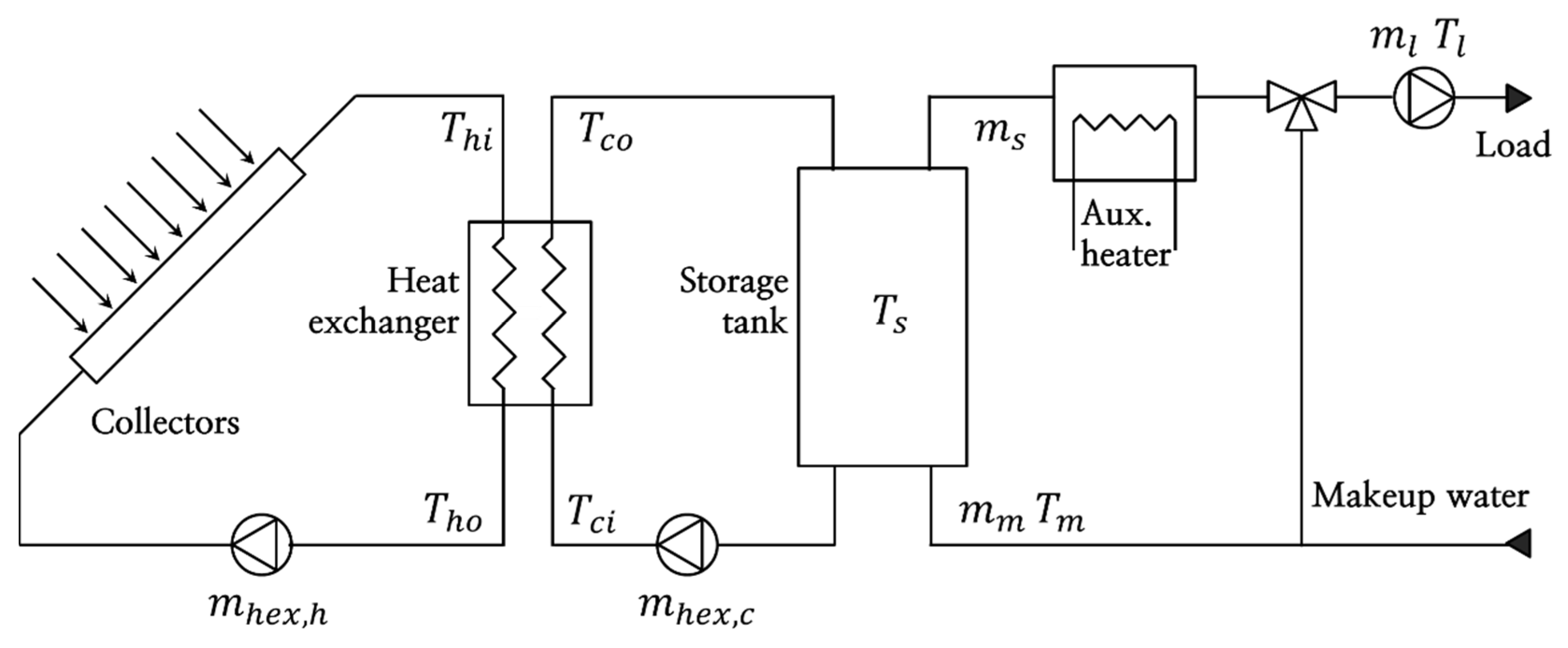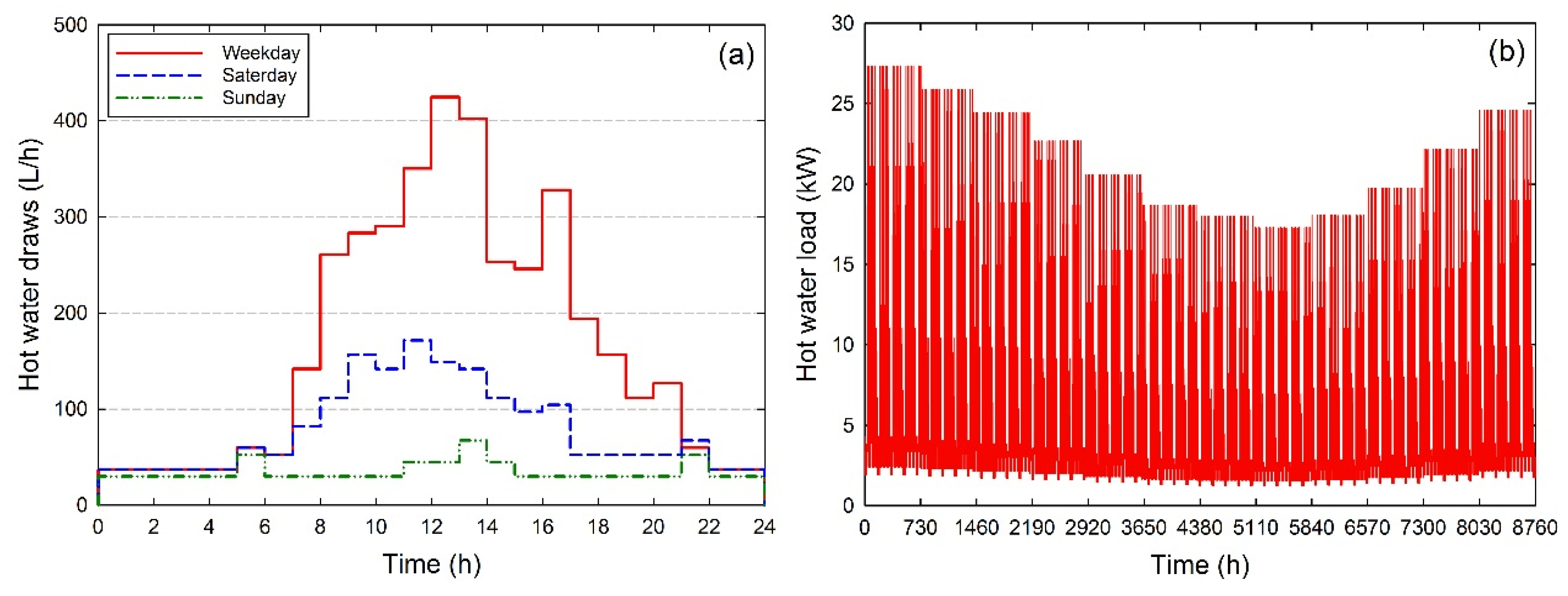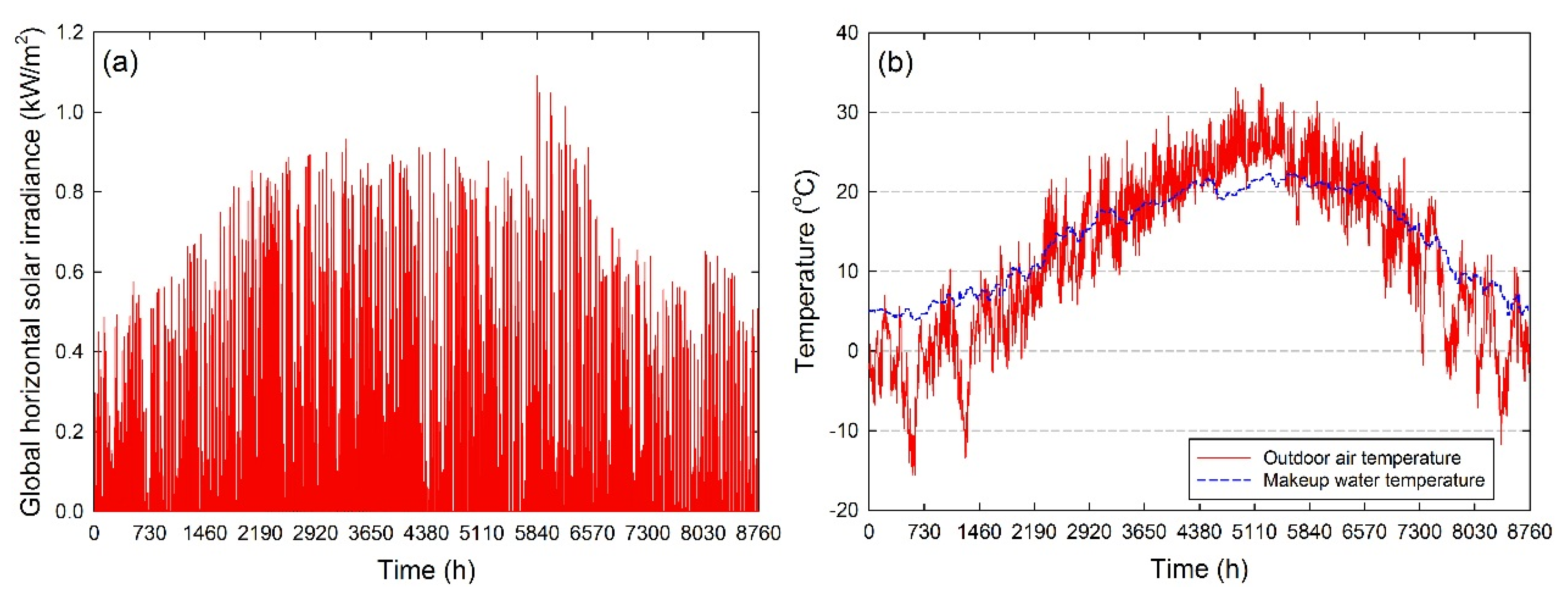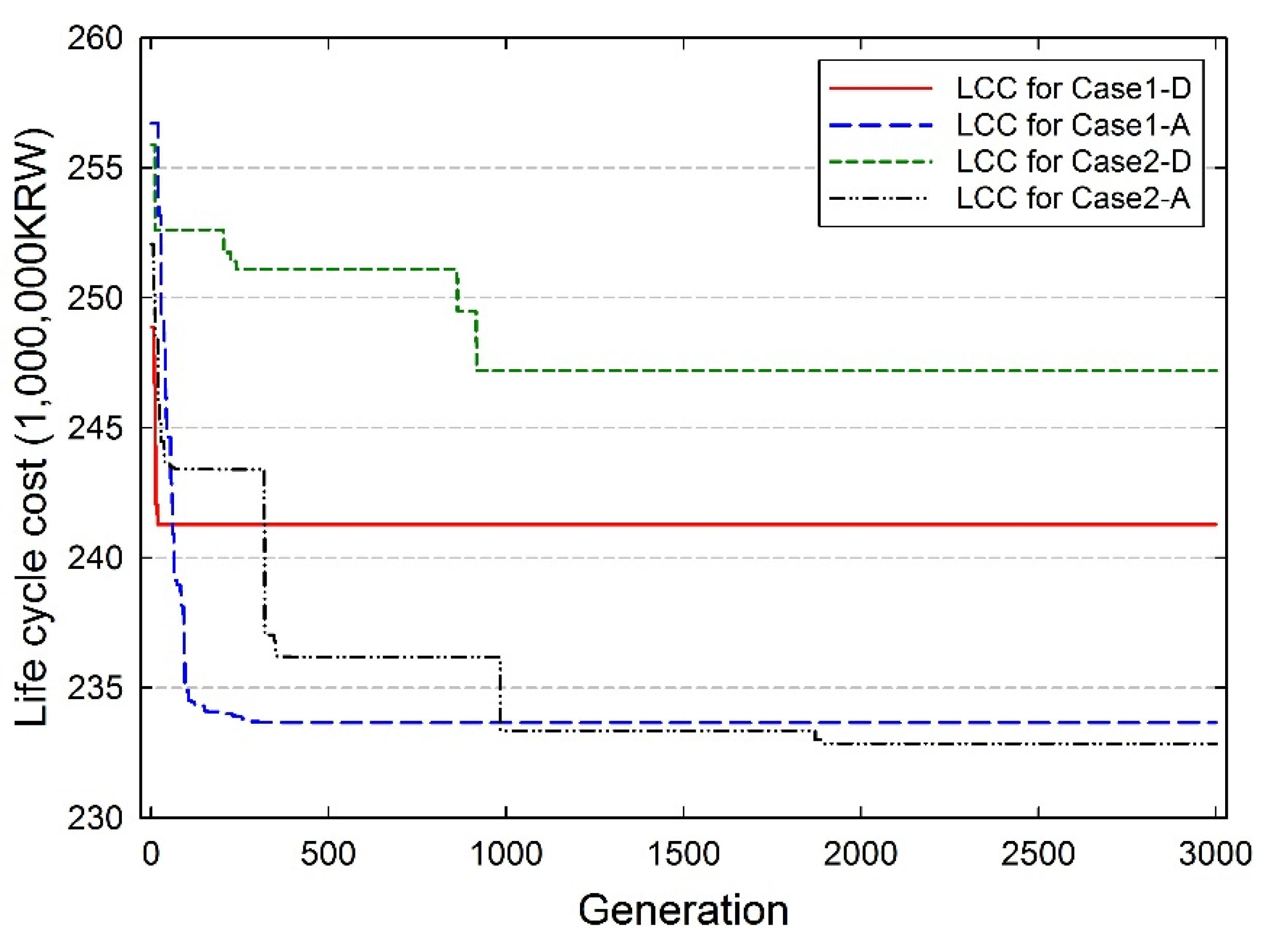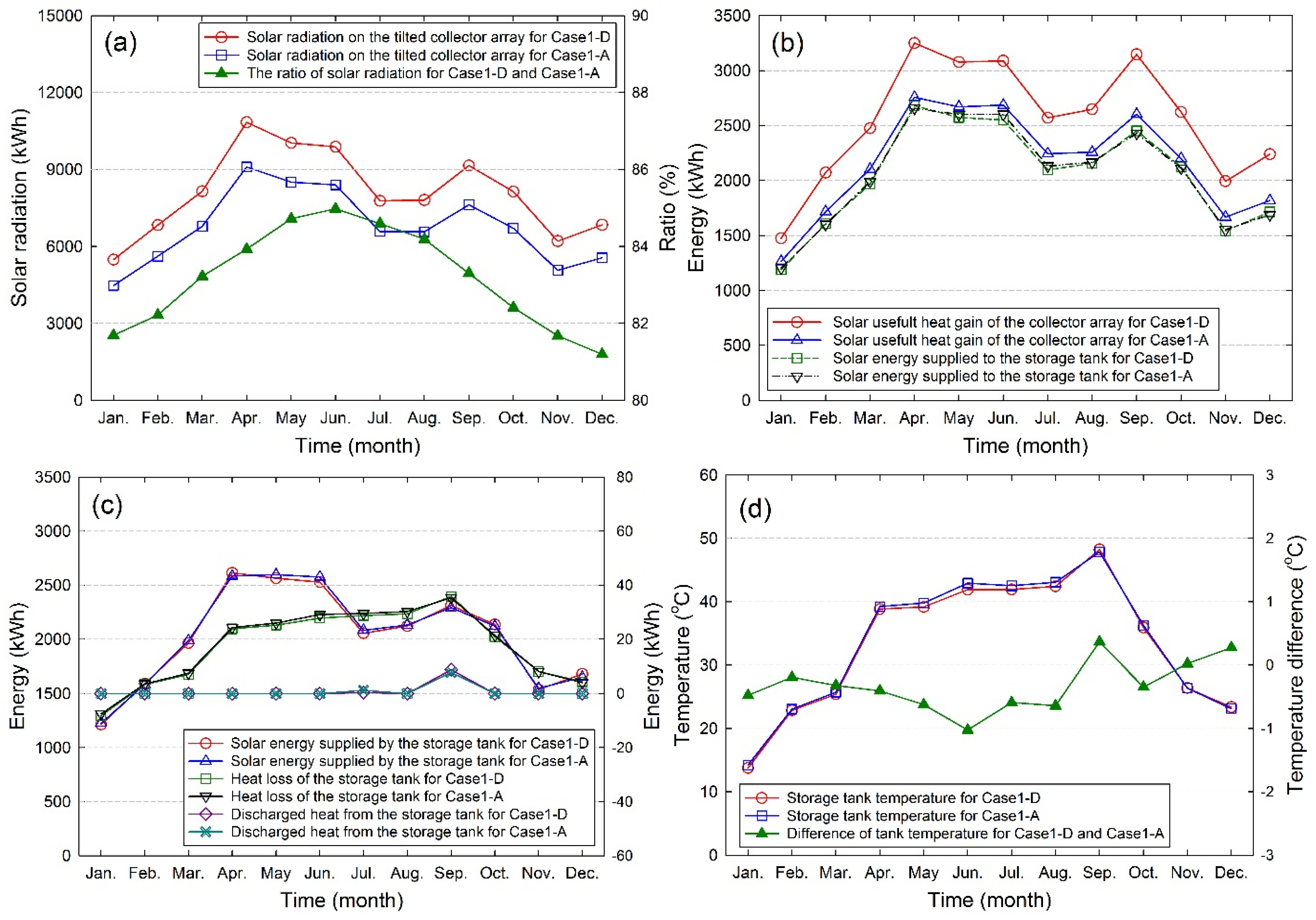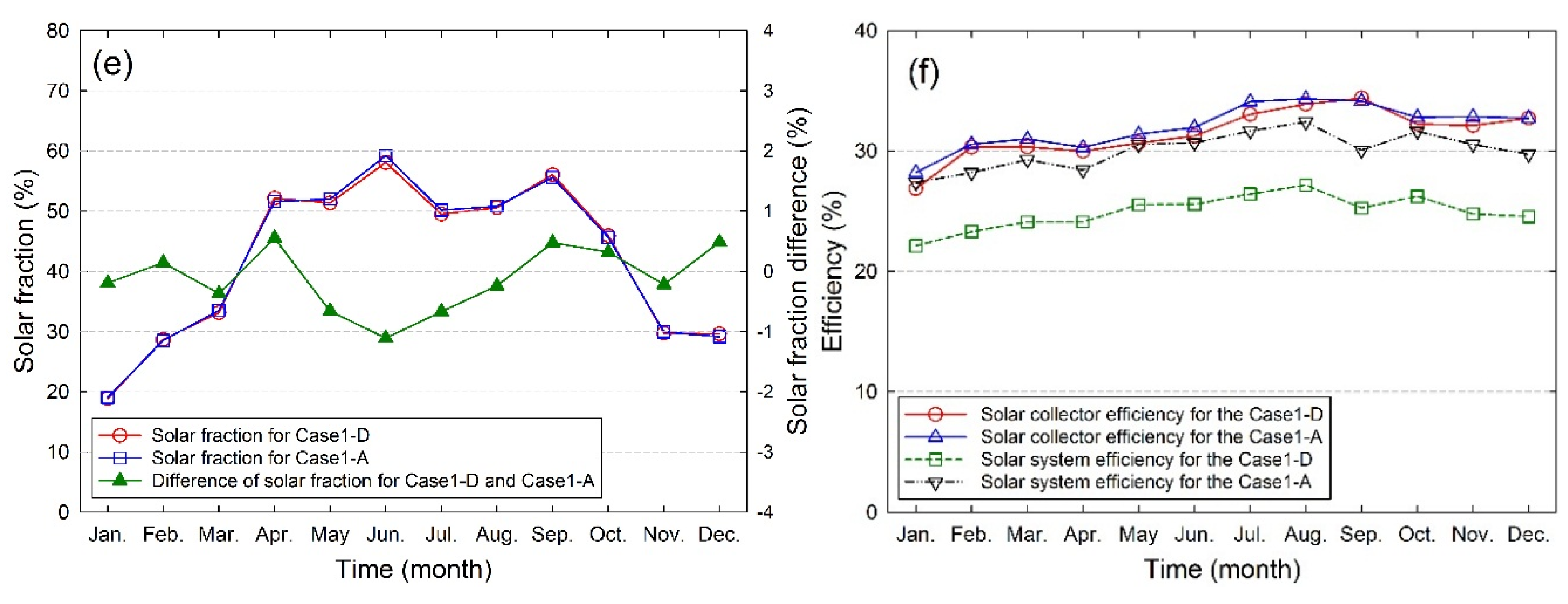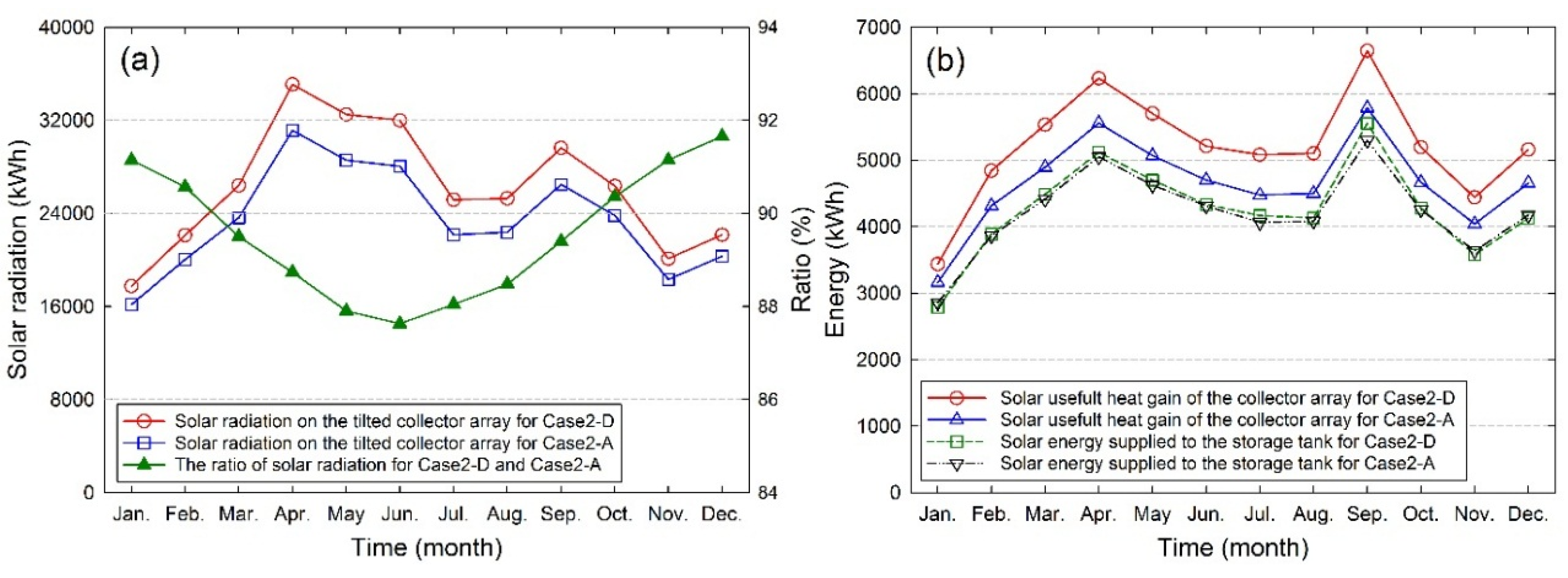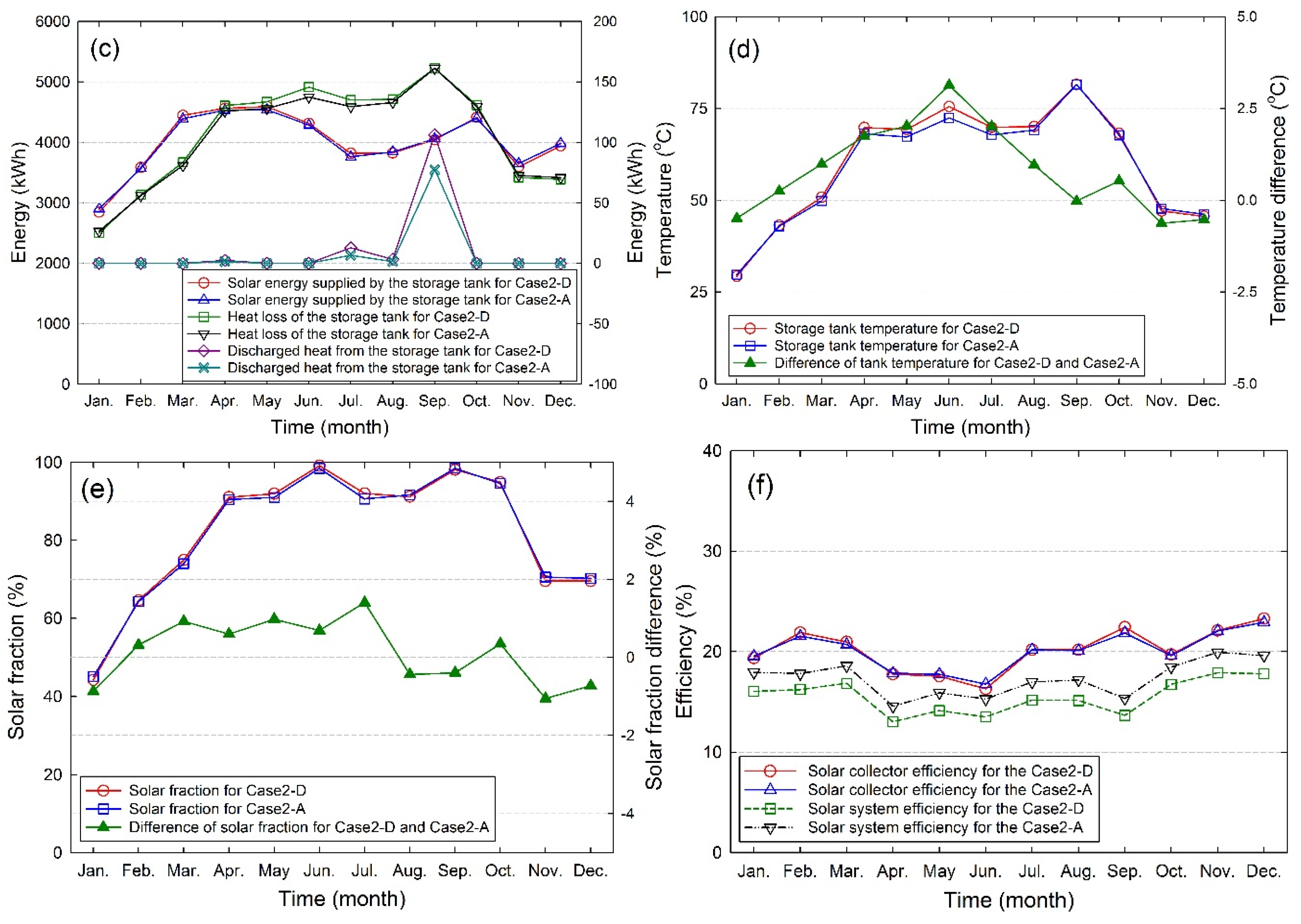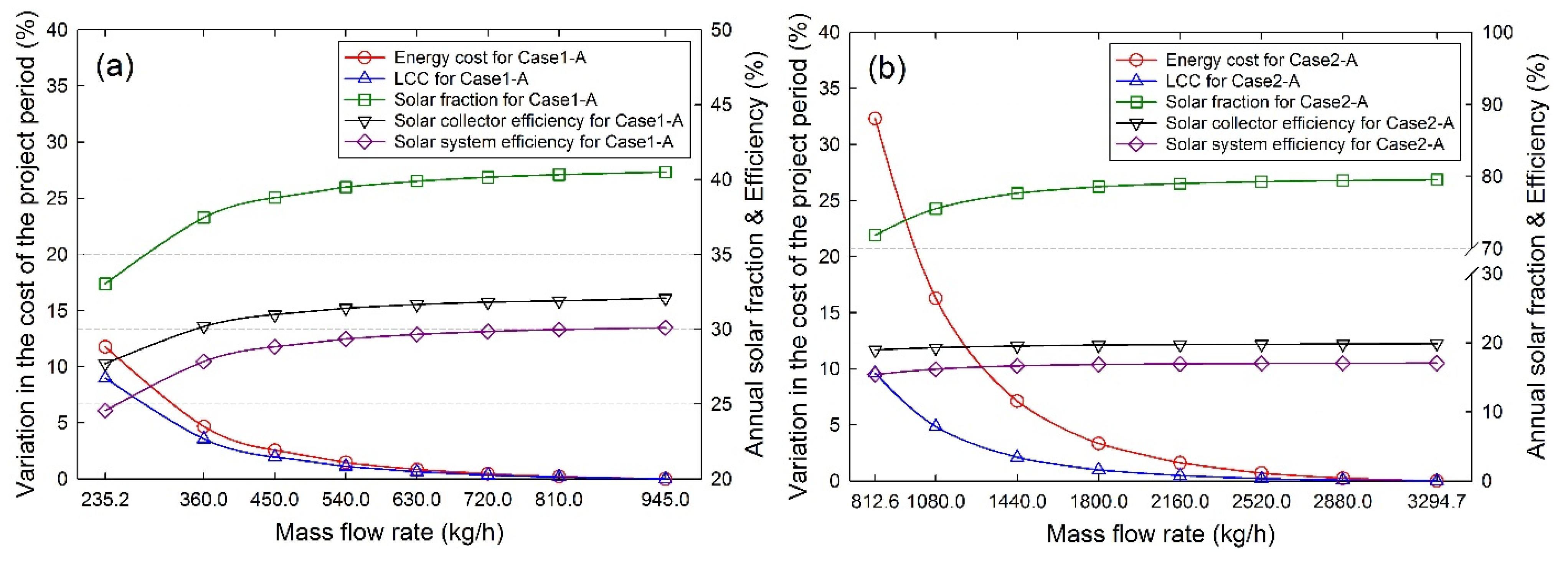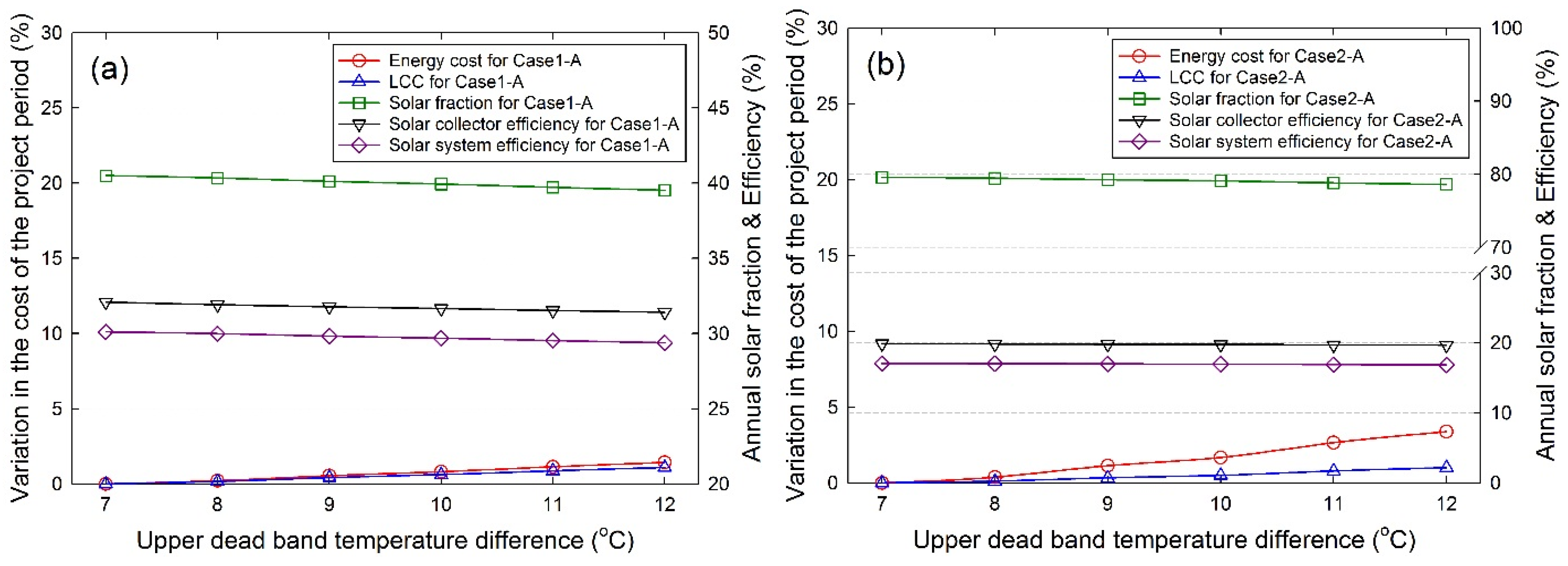4.1. Case Study Description and Parameters
The effectiveness of the suggested optimization method was assessed by analyzing four case studies, each of which was simulated with different sets of design variables and solar fractions. Case1-D and Case1-A were optimized at an annual solar fraction of 40%, which is representative of a wide range of solar applications in South Korea. Case2-D and Case2-A were optimized at an annual solar fraction of 80%, in order to analyze the optimization characteristics of an SWH system with a high solar fraction. Furthermore, to evaluate the variation in the optimization designs of the SWH system with the design variables, the case studies were optimized with respect to the set of the different design variables. For Case1-D and Case2-D, six design variables—, , , , , and —were optimized. These only determine the size of the main components of an SWH system in a manner similar to the case studies taken from the literature. In Case1-A and Case2-A, 11 design integer variables were optimized, as shown in Equation (30). These included operation-related variables as well as capacity-related variables. For Case1-D and Case2-D, the operation-related variables were = 35°, = the mass flow rate per unit collector area under the tested conditions, = , = 8 °C, and = 2 °C.
For the case studies, it was assumed that SWH system was installed in an office building. The distributions of hot water consumption for three different cases—a weekday, Saturday, and Sunday—based on the hot water load profile of a typical office building [
23] are shown in
Figure 3a. The hourly hot water load profile over one year is shown in
Figure 3b. Weather data for Incheon (South Korea, latitude 36° N and longitude 125° E) were referred to.
Figure 4 shows the hourly global horizontal solar irradiance, outdoor air temperature, and make-up water temperature.
Figure 3.
(a) Hourly hot water consumption rates over one day; and (b) hot water load over one year in the building considered for the case studies.
Figure 3.
(a) Hourly hot water consumption rates over one day; and (b) hot water load over one year in the building considered for the case studies.
Figure 4.
(a) Hourly global horizontal solar irradiance; and (b) outdoor air temperature and make-up water temperature over one year for Incheon, South Korea.
Figure 4.
(a) Hourly global horizontal solar irradiance; and (b) outdoor air temperature and make-up water temperature over one year for Incheon, South Korea.
The proposed method involved the use of various commercially available devices, and the set of devices used can be extended by the designer. The technical and economic characteristics of the solar collectors, heat exchangers, storage tanks, and auxiliary heaters used are summarized in the
Table A1,
Table A2,
Table A3,
Table A4 and
Table A5 at the end of this paper.
Table 1 shows the design parameters used as well as the assumptions made for the optimization process.
Table 2 shows the electricity and LNG tariffs for an office building in South Korea.
Table 1.
Optimization design parameters considered in case study.
Table 1.
Optimization design parameters considered in case study.
| Parameter | Description | Value |
|---|
| Azimuth of collector array (Degrees) | 0 |
| Meridian altitude in winter (° Degrees) | 29 |
| Desired hot water temperature (°C) | 60 |
| Maximum allowable storage tank temperature (°C) | 100 |
| Temperature of environment surrounding storage tank (°C) | 20 |
| Specific heat capacity of collector fluid (J/kg·°C) | 3843 |
| Specific heat capacity of water (J/kg·°C) | 4153 |
| Density of collector fluid (kg/m3) | 1032 |
| Density of water (kg/m3) | 991 |
| Pumping efficiency of circulation pump (%) | 60 |
| Motor efficiency of circulation pump (%) | 80 |
| Head of pump on hot side of heat exchanger (m) | 80 |
| Head of pump on cold side of heat exchanger (m) | 15 |
| Head of pump on load side of SWH system (m) | 80 |
| Project lifetime (years) | 40 |
| Real discount rate (%) | 2.91 |
| Electricity cost escalation rate (%) | 4.00 |
| Gas cost escalation rate (%) | 4.00 |
| Maximum capacity available to receive subsidy cost (m2) | 500 |
| Area available to install solar collectors (m2) | 600 |
| Supplementary cost ratio against purchase cost (%) | 30 |
| Maintenance cost ratio against initial cost (%) | 1.5 |
| Subsidy cost ratio against initial cost (%) | 50 |
Table 2.
Electricity and LNG tariffs.
Table 2.
Electricity and LNG tariffs.
| Classification | Value |
|---|
| Electricity | Basic charge | 6160 |
| Energy charge (KRW/kW·h) | Summer (June, July, and August) | 105.7 |
| Spring/Fall (March, April, May, September, and October) | 65.2 |
| Winter (November, December, January, and February) | 92.3 |
| Natural gas | Energy charge (KRW/MJ) | Summer (May, June, July, August, and September) | 19.26 |
| Spring/Fall (April, October, and November) | 19.28 |
| Winter (December, January, February, and March) | 19.46 |
4.2. Optimization Results Based on Set of Design Variables
This case study aimed to optimize the design of SWH systems such that their LCC was minimized.
Figure 5 shows the convergence of the objective functions of the four cases. The values of the objective function obtained for Case1-A and Case2-A are better than those obtained for Case1-D and Case2-D. In other words, the systems corresponding to Case1-A and Case2-A exhibited LCCs that were ~3.2% and ~6.1% lower than those for the systems corresponding to Case1-D and Case2-D, respectively.
Figure 6 shows that the costs of the systems for Case1-A and Case2-A were lower than those of the systems for Case1-D and Case2-D; this was true for all cost items except the subsidy cost. Therefore, an optimization method that takes the installation and operation-related variables into account is obviously superior to one that only considers the capacity-related variables.
Table 3 shows a comparison of the results obtained for each case. As expected, the optimal values of the design variables and the corresponding values of the objective function varied for each case, depending on the set of the design variables.
Figure 5.
Evolution of the objective functions for each case.
Figure 5.
Evolution of the objective functions for each case.
Figure 6.
Comparison of the cost items for each case.
Figure 6.
Comparison of the cost items for each case.
The capacity-related design variables for Case1-A and Case2-A, namely the volume of the storage tank and the heating capacity of the auxiliary heater, are the same as those for Case1-D and Case2-D, respectively. However, the area of the collector array and the overall heat transfer coefficient–area product of the heat exchanger for Case1-A and Case2-A were lower that those for Case1-D and Case2-D. The installation and operation-related design variables such as
,
,
,
, and
also vary. These differences in the design variables are analyzed in
Figure 7 and
Figure 8.
Table 3.
Characteristics of the optimal SWH systems for each case.
Table 3.
Characteristics of the optimal SWH systems for each case.
| Parameter | Classification |
|---|
| Case1-D | Case1-A | Case2-D | Case2-A |
|---|
| (-) | 1 | 4 | 4 | 4 |
| (ea.) | 37 | 31 | 121 | 109 |
| (-) | 9 | 6 | 16 | 14 |
| (-) | 0 | 0 | 6 | 6 |
| (-) | 4 | 4 | 4 | 4 |
| (ea.) | 1 | 1 | 1 | 1 |
| (°) | 35 | 31 | 35 | 39 |
| (kg/s·m2) | 0.0187 | 0.011 | 0.0186 | 0.012 |
| (kg/s) | 0.2611 | 0.2625 | 0.7728 | 0.9152 |
| (°C) | 8 | 7 | 8 | 7 |
| (°C) | 2 | 1 | 2 | 1 |
| (m2) | 74 | 61.38 | 239.58 | 215.82 |
| (W/°C) | 3489 | 2035 | 9304 | 6978 |
| (m3) | 0.96 | 0.96 | 6.21 | 6.21 |
| (kW) | 34.89 | 34.89 | 34.89 | 34.89 |
| (kW) | 27.35 | 27.35 | 27.35 | 27.35 |
| (kW·h/year) | 60218 | 60218 | 60218 | 60218 |
| (kW·h/year) | 97168 | 81004 | 314591 | 281083 |
| (kW·h/year) | 30664 | 25989 | 62589 | 55826 |
| (kW·h/year) | 24654 | 24733 | 51157 | 50626 |
| (kW·h/year) | 207 | 212 | 1278 | 1252 |
| (kW·h/year) | 9 | 9 | 125 | 87 |
| (kW·h/year) | 24323 | 24388 | 47984 | 47914 |
| (kW·h/year) | 35895 | 35830 | 12234 | 12304 |
| (%) | 40.39 | 40.50 | 79.68 | 79.57 |
| (1000 KRW) | 241278 | 233668 | 247854 | 232854 |
Figure 7 shows a comparison of the monthly energy performances of the optimal SWH systems corresponding to Case1-D and Case1-A. As shown in
Figure 7a, the total solar radiation on the collector array of the optimal SWH system for Case1-A is ~16.6% lower than that for the optimal system for Case1-D. This is because of a 17.1% reduction in the area of the collector array. However, the slope of the collector array (
) is reduced from 35° to 31°, so that the decrease in the summer and the intermediate season is less than that in the winter. Depending on the decrease in the total solar radiation, as shown in
Figure 7b, the useful solar heat gain for Case1-A is reduced by ~15.3%; however, the solar energy supplied to the storage tank is increased slightly by ~0.3%, compared to that for Case1-D. This results from an increase in the heat exchanger effectiveness which in turn, leads to an increase in the
and a decrease in the capacity rate ratio (
), owing to a decrease in the mass flow rate on the hot side of the heat exchanger (
) and an increase in the mass flow rate on the cold side (
). The value of
for Case1-A is 0.932; this is ~16.7% higher compared to that (0.798) for Case1-D. In addition, it is assumed that the increase in the operating time of the circulation pump for Case1-A, owing to the decrease in
and
, in contrast to Case1-D, allows for the supply of more solar energy to the storage tank. As shown in
Figure 7c, the amounts of solar energy supplied by the storage tank (
), the heat losses of the storage tank (
), and the amounts of heat discharged from the storage tank (
) on a monthly basis for Case1-A and Case1-D are very similar. Therefore, it can be seen from
Figure 7d that the similarity between the monthly average storage tank temperatures for Case1-A and Case1-D are similar, even though the monthly average temperature for Case1-A is slightly higher than that for Case1-D for all months except September, November, and December. This is because of the decrease in
and the increase in the effectiveness of the heat exchanger. As a result, it can be seen from
Figure 7e that the monthly solar fractions for Case1-A and Case1-D are very similar. However, owing to the effects of the installation and operation-related design variables (see
Figure 7f), the annual collector efficiency and annual SWH system efficiency for Case1-A are ~1.2% and ~5.1%, respectively, higher than those of Case1-D. Therefore, the annual energy cost for Case1-A is ~0.9% lower than that for Case1-D.
Figure 7.
Comparison of the monthly energy performances of optimal SWH systems corresponding to Case1-D and Case1-A: (a) solar radiation; (b) useful solar heat gain and solar energy supplied to the storage tank; (c) solar energy supplied by the storage tank, heat loss of the storage tank, and heat discharged from the storage tank; (d) storage tank temperature; (e) solar fraction; and (f) solar collector efficiency and solar system efficiency.
Figure 7.
Comparison of the monthly energy performances of optimal SWH systems corresponding to Case1-D and Case1-A: (a) solar radiation; (b) useful solar heat gain and solar energy supplied to the storage tank; (c) solar energy supplied by the storage tank, heat loss of the storage tank, and heat discharged from the storage tank; (d) storage tank temperature; (e) solar fraction; and (f) solar collector efficiency and solar system efficiency.
Figure 8 shows a comparison of the monthly energy performances of the optimal SWH systems corresponding to Case2-D and Case2-A and optimized at an annual solar fraction of 80%.
Figure 8e shows that the monthly average solar fractions for Case2-D and Case2-A are 91.1%–99.2% and 90.5%–98.5%, respectively, from April to October. Therefore, it is more efficient to increase the solar fraction during winter because the solar fraction during the summer and the intermediate season is very close to the upper limit. Therefore,
for Case2-A is increased from 35° to 39° to collect more solar radiation in the winter.
Figure 8 shows the changes in the annual energy performance caused by this increase. Furthermore, after decreasing
and increasing
, the value of
for Case2-A is 0.932, which is ~19.7% higher than that for Case2-D (0.779). Decreasing the
and
values for Case2-A also increases the operating time of the circulation pump. Thanks to the optimization of the installation and the operation-related design variables, the decrease in the amount of solar energy supplied annually to the storage tank for Case2-A is only 1.0% compared to that for Case2-D. Furthermore, this decrease occurs primarily in the summer and the intermediate season; however, a greater amount of energy is supplied to the storage tank in the winter. Therefore, the annual SWH system efficiency for Case2-A is increased by ~2.25% and the annual energy cost is decreased by ~2.2% compared to those for Case2-D.
Figure 8.
Comparison of the monthly energy performances of the optimal SWH systems corresponding to Case2-D and Case2-A: (a) solar radiation; (b) useful solar heat gain and solar energy supplied to the storage tank; (c) solar energy supplied by the storage tank, heat loss of the storage tank, and heat discharged from the storage tank; (d) storage tank temperature; (e) solar fraction; and (f) solar collector efficiency and solar system efficiency.
Figure 8.
Comparison of the monthly energy performances of the optimal SWH systems corresponding to Case2-D and Case2-A: (a) solar radiation; (b) useful solar heat gain and solar energy supplied to the storage tank; (c) solar energy supplied by the storage tank, heat loss of the storage tank, and heat discharged from the storage tank; (d) storage tank temperature; (e) solar fraction; and (f) solar collector efficiency and solar system efficiency.
